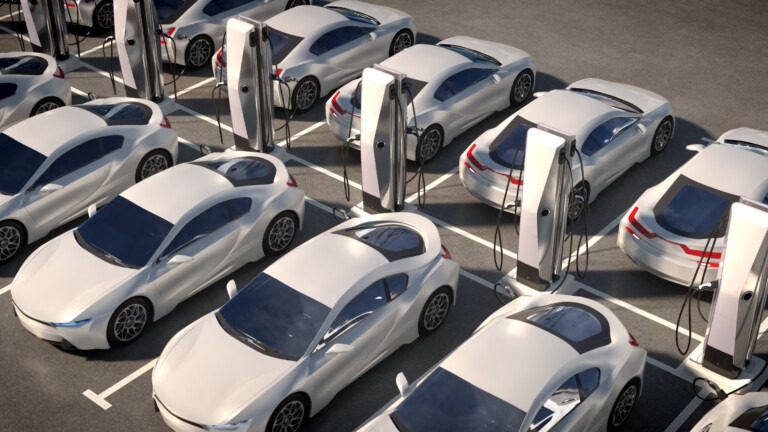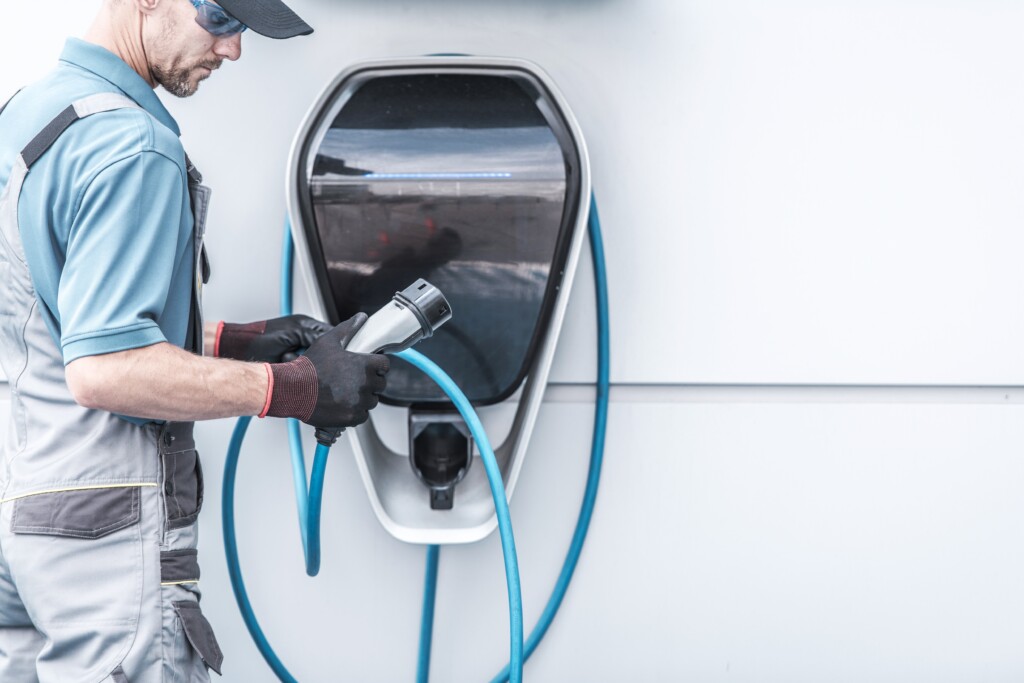How Industry Partnerships Are Driving EV Proliferation

When discussing electric vehicles (EV) with colleagues and friends, Petar Georgiev hears a lot of focus on the roles EVs will play in lowering CO2 emissions. Yet Georgiev’s passion for supporting a broad shift to EVs in both the fleet and consumer space is driven by a broader concern for public health.
“There are many pollutants from vehicles, and we breathe them in,” he said. “Pollution is really bad for our health. We want to be able to live a good life, and what’s more important than health?”
Georgiev is Head of Strategy & Partnerships at AMPECO, an EV charging and mobility solutions company based in Sofia, Bulgaria. He is also an EU Climate Pact Ambassador who has committed to inform, inspire, and support climate action in his community and networks.
He started his career as a lobbyist for an non-governmental organization, and then moved into several policy and lobbying roles at Eurelectric, an association that represents more than 3500 European utilities.
“You have representatives from different countries in Europe with different backstories, different conditions, different starting points for their energy transition,” he said, describing the challenges finding common ground amongst the membership. “That required a lot of creativity and diplomacy.”
He now applies those skills within the fast-growing EV industry. “You do need to understand the dynamics, and how to navigate,” he said

How EVs Will Drive Sustainability
According to Georgiev, the shift from combustion engines to EVs involves changing how we think about our transportation and electricity ecosystems. “The idea is that you are not switching from refueling your car to recharging your car – it’s more than that,” he said. “We’re moving toward a different model where the electric vehicle is part of the whole power system.”
Georgiev believes EVs, and their role in a transition to cleaner transportation networks, are linked to good corporate governance and strong GDPs, as well as helping improve health, particularly in urban centers. But there are still some challenges that need to be addressed to create a truly sustainable system that comprises more environmentally-friendly vehicles and infrastructure.
For example, said Georgiev, ensuring that vehicles and the ability to charge them are more affordable and accessible to individual consumers will help drive wider adoption. “That would really be helpful to scale up that transition and accelerate it.”
Another area for improvement is the sustainability of the vehicles themselves. Much like the challenge the IoT faces around becoming more eco-friendly by reducing device battery waste, EVs also have batteries that will eventually need to be replaced and recycled. The materials required to make those batteries – particularly cobalt – are often sourced in ways that are not always good for the environment or the people that mine them. However, efforts are underway to improve working conditions and lessen the environmental impact of these critical minerals. Solving these issues will smooth the shift to this new paradigm.
“The transition is coming,” Georgiev said. “The decision to go electric has been made, but now it’s really about getting the market to be suitable for a fully electric future. That’s what I want to work towards.”
The Role of IoT in the Growth of EV Infrastructure

As the market changes to more fully embrace EVs and their infrastructure, IoT solutions will play a critical role. Devices and their networks provide the data required for the corporate decision making needed to make EV infrastructure efficient and effective.
“The application will really be with those corporate drivers where you rely on real-time data,” Georgiev said. “The role and type of sensors and telematics that can be applied could be used by those bigger fleets that want to track their operations and better understand the behavior of the vehicle fleet.”
Georgiev said the IoT is an essential part of the ecosystem approach that he thinks is critical to a successful EV transition. For example, if part of a particular EV charging station is not working, IoT allows operators to remotely survey and potentially address the situation without having to send staff onsite. This requires open protocols and appropriate connectivity so different vendors can work together, and storing and sharing data in secure ways. “You need to have quite a lot of elements together,” he said. “And I think then you could talk about doing that at scale.”
Though IoT-based EV infrastructure can have security vulnerabilities, Georgiev said corporate infrastructure is comparatively more secure than private, home charging stations. Because there are often corporate partnerships involved in creating the shared protocols needed for elements of a charging station to work together, this is an area where the sector is seeing good and productive collaboration.
Collaboration Makes EV Tech More Affordable
One of the reasons collaboration is so effective, Georgiev said, is because it helps make the technology more affordable. “Open protocols are a way to lower the costs not only for different companies, but ultimately for the consumer as well,” he said.
Developing those protocols and standards are a way in which he sees companies cooperating with each other. It’s a less political process because it yields commercial benefits for all involved.
“That can be in the context of reducing some of the strain on the energy system,” he said. “It could be in the context of data, and it could also be in the context of payment or billing. Though some companies have their proprietary protocols, most are moving toward the use of open protocols and standards.”
Partnerships are also benefiting the sector as companies pledge to lead the shift to EV fleets and more broadly available charging systems. The Climate Group’s EV100 initiative has already brought together 123 companies that have pledged to fully electrify their fleets, said Georgiev. Though there may be a higher up-front cost to purchase electric vehicles, over time, these companies are looking at a more sustainable total cost of ownership, as well as the overall benefits created over the life of each vehicle.
“It really has to start with those bigger companies that have the ability to make such a purchasing decision,” he said. “Right now, we’re at a place where the total cost of ownership for electric vehicles in some markets is already less than for a combustion engine of the same class.”

How Partnerships Boost EV Infrastructure Innovation
As companies form industry alliances and collaborate on protocols, Georgiev said they also have an opportunity to learn from each other. That knowledge sharing, in turn, can spark innovation around the flexibility and interconnectedness of the charging infrastructure needed to support the sector.
“It’s important for companies to communicate,” he said. “Our core business is a charging point management system, which is the platform on top of which you can plug in other solutions. And we want to have that flexibility to be able to integrate with different solutions freely and without those technology lock-ins that would ultimately limit the ability of the client or the end-user to use the best of the product at the most affordable cost.”
According to Georgiev, many companies are actually boosting innovation through mergers and acquisitions of smaller companies, something he feels is happening more often in the current economic environment. “Companies, when they’re successful, focus either on providing the basis for a solution or a very niche aspect,” he said. “Sometimes some of those bigger companies can end up buying some of those smaller ones that provide those individual features, and they put them in a complete solution.”
One of the ways companies may be able to leverage the strength of partnerships is to address the supply chain issues that are expected to continue at least for the near future. Manufacturers of the components of EV charging infrastructure have experienced more pronounced disruption in recent months, Georgiev said due to a shortage of microchips and other materials necessary to build chargers. He believes that has the potential to dramatically affect how affordable EVs will be for organizations and individual consumers.
“There are a lot of manufacturers that are really not able to fulfill the demand,” he said. “Whoever’s able to make the bigger order probably gets the resources first, and it’s the same when purchasing a charger.”
Adjusting Expectations, Reaping Benefits
The change from combustion engines to EVs will require some adjustment to consumer and corporate expectations around transportation. “It’s a different approach, and in some cases, you have to sacrifice some of the comfort,” Georgiev said. “If you’re in a rush and you have to travel 400 kilometers, but your car can only do 300, then you have to stop and wait.”
But Georgiev thinks the environmental benefits are worth it. “We can sacrifice 30 minutes to wait at a charging station,” he said, “if we don’t have to breathe in fumes every day, I think it’s a good trade-off.”
****

To hear more on these topics from AMPECO’s Petar Georgiev, check out Taking Charge: EV Infrastructure Rollouts Done Right. This free webinar covers how to anticipate and address the operational and technical challenges of EV charging infrastructure rollout, and is now available on-demand.



